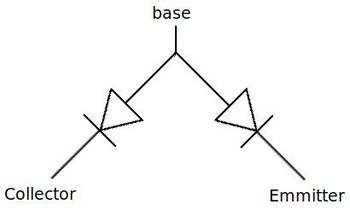Electronic Circuits/Introduction to the simple diode npn model
A NPN transistor is composed of a N-type -P-type - N-type material. WE can view it this way. This model is very very simplistic. It is useful for determining the mode the transistor is in and help to visualize what else is going on. Please use caution. Transistor analysis is the art of knowing where and when what type of models should be used.

Equations
editWith this model the following equations can be derived 1) Think of a transistor as a non-linear resistor, with diodes, between the base and the collector whose value in Ohms is changed by the value of the current flowing into the base. Study the graphs that are supplied by the manufacturer and you can derive, within limits, approximate equations from those graphs.
Terminology
editThe diode between the base and collector is often called the BC junction, the one between the base and emitter junction is often called the BE junction.
Circuit Diagram and Circuit Symbol
editThe Circuit Diagram and Circuit Symbol of an npn diode is shown in the figure and also the flow of current through the diode is also calculated through the mentioned equation.
IE = IB+IC
Important note
editThere are actually two versions of this model. The first model views the diodes as merely switchs that allow current to pass when the anode is at a higher potential then the cathode. The other model requires that the anode be not only at a higher voltage but that it has to be higher by a certain amount. This amount for the EBJ diode is called Vbe(on) the amount for the CBJ diode is Vbc (on). Typical values for these terms are around .3 volts for the Vbe (on) and .4 volts for the Vbc (on).
Forward vs. Reverse
editIf the junction diode is conducting, then it is said to be in forward mode. If the junction diode is not conducting, the it is said to be in reverse mode.
Derivations
editSo for our simplified model
- EBJ is forward if and only if Vb > Ve. i.e. the voltage at the base is higher then the voltage at the emitter.
- CBJ is forward if and only if Vb > Vc. i.e. the voltage at the base is higher then the voltage at the collector.
- otherwise the diode is reverse.
For our model with Vbe (on) and V bc (on)
- EBJ is forward if and only if Vb > Ve + Vbe(on). i.e. the voltage at the base is higher then the voltage at the emitter by the value of Vbe(on).
- CBJ is forward if and only if Vb > Vc + Vbc(on). i.e. the voltage at the base is higher then the voltage at the collector by the value of Vbc(on).
- otherwise the diode is reverse.